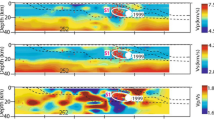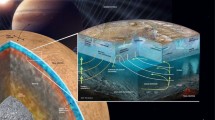Abstract
As a supplementary study, we used passive seismic data recorded by one ocean bottom seismometer (OBS) station (49°41.8′E) close to a hydrothermal vent (49°39′E) at the Southwest Indian Ridge to invert the crustal structure and mantle transition zone (MTZ) thickness by P-to-S receiver functions to investigate previous active seismic tomographic crustal models and determine the influence of the deep mantle thermal anomaly on seafloor hydrothermal venting at an ultra-slow spreading ridge. The new passive seismic S-wave model shows that the crust has a low velocity layer (2.6 km/s) from 4.0 to 6.0 km below the sea floor, which is interpreted as partial melting. We suggest that the Moho discontinuity at ~9.0 km is the bottom of a layer (2–3 km thick); the Moho (at depth of ~6–7 km), defined by active seismic P-wave models, is interpreted as a serpentinized front. The velocity spectrum stacking plot made from passive seismic data shows that the 410 discontinuity is depressed by ~15 km, the 660 discontinuity is elevated by ~18 km, and a positive thermal anomaly between 182 and 237 K is inferred.







Similar content being viewed by others
References
Baker ET, Edmonds HN, Michael PJ et al (2004) Hydrothermal venting in magma deserts: the ultraslow-spreading Gakkel and Southwest Indian Ridges. Geochem Geophys Geosyst 5(8):217–228. doi:10.1029/2004GC000712
Bina CR, Helffrich GR (1994) Phase transition Clapeyron slopes and transition zone seismic discontinuity topography. J Geophys Res 99(B8):15853–15860
Cannat M (1993) Emplacement of mantle rocks in the seafloor at mid-ocean ridges. J Geophys Res 98(B3):4163
Cannat M, Rommevaux-Jestin C, Sauter D et al (1999) Formation of the axial relief at the very slow spreading Southwest Indian Ridge (49° to 69°E). J Geophys Res Solid Earth 104(B10):22825–22843
Cannat M, Sauter D, Bezos A et al (2008) Spreading rate, spreading obliquity, and melt supply at the ultraslow spreading Southwest Indian Ridge. Geochem Geophys Geosyst 9(4):144–144. doi:10.1029/2007GC001676
Chu D, Gordon RG (1999) Evidence for motion between Nubia and Somalia along the Southwest Indian Ridge. Nature 398:64–67
Coleman RG (1977) Ophiolites: ancient oceanic lithosphere. Springer, Berlin, pp 229
Das Sharma S, Ramesh DS, Li X et al (2010) Response of mantle transition zone thickness to plume buoyancy flux. Geophys J Int 180(1):49–58
Dziewonski A, Anderson DL (1981) Preliminary reference Earth model. Phys Earth Planet Inter 25:297–356
Efron B, Tibshirani R (1986) Bootstrap methods for standard errors, confidence intervals, and other measures of statistical accuracy. Stat Sci 1(1):75–77
Fee D, Dueker K (2004) Mantle transition zone topography and structure beneath the Yellowstone hotspot. Geophys Res Lett 31(18):169–188. doi:10.1029/2004GL020636
Foulger GR, Pritchard MJ, Julian BR et al (2000) The seismic anomaly beneath Iceland extends down to the mantle transition zone and no deeper. Geophys J Int 142(3):F1–F5
Gu YJ, Dziewonski AM, Agee CB (1998) Global de-correlation of the topography of transition zone discontinuities. Earth Planet Sci Lett 157(1–2):57–67
Gurrola H, Minster J, Owens T (1994) The use of velocity spectrum for stacking receiver functions and imaging upper mantle discontinuities. Geophys J Int 117(2):427–440
Helffrich G (2000) Topography of the transition zone seismic discontinuities. Rev Geophys 38(38):141–158
Humphris SE, Kleinrock MC (1996) Detailed morphology of the TAG active hydrothermal mound: insights into its formation and growth. Geophys Res Lett 23(23):3443–3446
Ito E, Takahashi E (1989) Postspinel transformations in the system Mg2SiO4–Fe2SiO4 and some geophysical implications. J Geophys Res 94(B8):10637–10646
Katsura T, Ito E (1989) The system Mg2SiO4–Fe2SiO4 at high pressures and temperatures: precise determination of stabilities of olivine, modified spinel, and spinel. J Geophys Res 94(B11):15663–15670
Kennett BLN, Engdahl ER (1991) Travel times for global earthquake location and phase identification. Geophys J Int 105(2):429–465
Li JB, Chen YJ (2010) First Chinese OBS experiment at Southwest Indian Ridge. InterRidge News 19:16–28
Li J, Jian H, Chen YJ et al (2015) Seismic observation of an extremely magmatic accretion at the ultraslow spreading Southwest Indian Ridge. Geophys Res Lett 42(8):2656–2663. doi:10.1002/2014GL062521
Minshull TA, Muller MR, Robinson CJ et al (1998) Is the oceanic Moho a serpentinization front? Geol Soc Lond Spec Publ 148:71–80. doi:10.1144/GSL.SP.1998.148.01.05
Niu X, Ruan, A, Li J et al (2015) Along axis variation in crustal thickness at the ultraslow spreading Southwest Indian Ridge (50°E) from a wide-angle seismic experiment. Geochem Geophys Geosyst 16(2):468–485. doi:10.1002/2014GC005645
Owens TJ (1984) Determination of crustal and upper mantle structure from analysis of broadband teleseismic P-waveforms. PhD thesis, University of Utah, Salt Lake City
Rona PA, Klinkhammer G, Nelsen TA et al (1986) Black smokers, massive sulfides and vent biota at the mid-Atlantic Ridge. Nature 321(6065):33–37
Sambridge M (1999a) Geophysical inversion with a neighbourhood algorithm—I. Searching a parameter space. Geophys J Int 138(2):479–494
Sambridge M (1999b) Geophysical inversion with a neighbourhood algorithm—II. Appraising the ensemble. Geophys J Int 138(3):727–746
Sambridge M (2001) Finding acceptable models in nonlinear inverse problems using a neighbourhood algorithm. Inverse Prob 17(3):387
Sambridge M, Mosegaard K (2002) Monte Carlo methods in geophysical inverse problems. Rev Geophys 40(3):3-1–3-29
Sauter D, Patriat P, Rommevauxjestin C et al (2001) The Southwest Indian Ridge between 49°15′E and 57°E: focused accretion and magma redistribution. Earth Planet Sci Lett 192(3):303–317. doi:10.1016/S0012-821X(01)00455-1
Si S, Tian X, Zhang H, Teng J (2013) Prevalent thickening and local thinning of the mantle transition zone beneath the Baikal rift zone and its dynamic implications. Sci China Earth Sci 56(1):31–42
Suetsugu D, Shinohara M, Araki E et al (2005) Mantle discontinuity depths beneath the West Philippine Basin from receiver function analysis of deep-sea borehole and seafloor broadband waveforms. Bull Seismol Soc Am 95(5):1947–1956
Tao C, Li H, Huang W et al (2011) Mineralogical and geochemical features of sulfide chimneys from the 49°39′E hydrothermal field on the Southwest Indian Ridge and their geological inferences. Chin Sci Bull 56(26):2828–2838. doi:10.1007/s11434-011-4619-4
Tao C, Lin J, Guo S et al (2012) First active hydrothermal vents on an ultraslow-spreading center: Southwest Indian Ridge. Geology 40(1):47–50. doi:10.1130/G32389.1
Tauzin B, Debayle E, Wittlinger G (2008) The mantle transition zone as seen by global Pds phases: no clear evidence for a thin transition zone beneath hotspots. J Geophys Res 113(B8):4177–4183. doi:10.1029/2007JB005364
Xu W, Zheng T, Zhao L (2011) Mantle dynamics of the reactivating North China Craton: constraints from the topographies of the 410-km and 660-km discontinuities. Sci China Earth Sci 54 (6):881–887
Zhang J, Zhao M, Qiu X et al (2013) Seismic phases from the Moho and its implication on the ultraslow spreading ridge. Acta Oceanol Sin 32(12): 75–86
Zhao M, Qiu X, Li J et al (2013) Three-dimensional seismic structure of the Dragon Flag oceanic core complex at the ultraslow spreading Southwest Indian Ridge (49°39′E). Geochem Geophys Geosyst 3(10):4544–4563. doi:10.1002/ggge.20264
Zhu L, Kanamori H (2000) Moho depth variation in southern California from teleseismic receiver functions. J Geophys Res 105(B2):2969–2980
Zhu J, Lin J, Chen YJ et al (2010) A reduced crustal magnetization zone near the first observed active hydrothermal vent field on the Southwest Indian Ridge. Geophys Res Lett 37(18):389–390. doi:10.1029/2010GL043542
Acknowledgements
We are grateful to the scientists and crew of the DY115-21 cruise (Leg 6) of the R/V “Dayang Yihao”, especially Prof. John Chen, Prof. Xuelin Qiu and Prof. Minghui Zhao. The study is supported by the National Basic Research program of China (Grant 2012CB417301), and the National Natural Science Foundation of China (Grants 91228205, 41576037 and 41176046).
Author information
Authors and Affiliations
Corresponding author
Electronic supplementary material
Below is the link to the electronic supplementary material.
Rights and permissions
About this article
Cite this article
Ruan, A., Hu, H., Li, J. et al. Crustal structure and mantle transition zone thickness beneath a hydrothermal vent at the ultra-slow spreading Southwest Indian Ridge (49°39′E): a supplementary study based on passive seismic receiver functions. Mar Geophys Res 38, 39–46 (2017). https://doi.org/10.1007/s11001-016-9298-8
Received:
Accepted:
Published:
Issue Date:
DOI: https://doi.org/10.1007/s11001-016-9298-8




